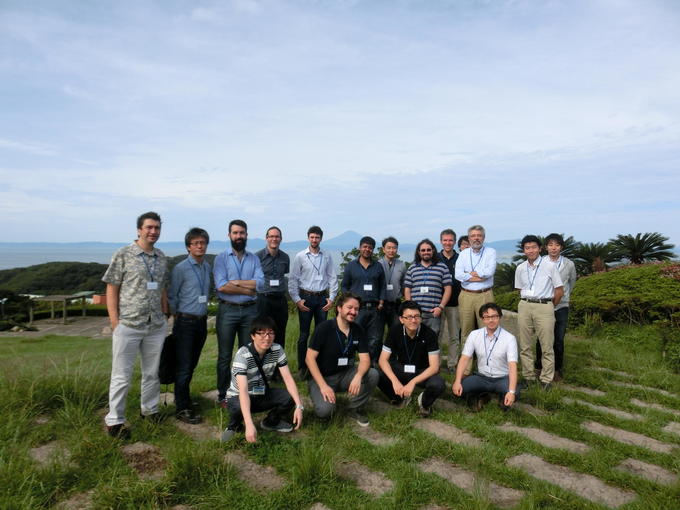NO.092 Cognitive Development and Symbol Emergence in Humans and Robots
October 3 - 7, 2016 (Check-in: October 2, 2016 )
Organizers
- Tadahiro Taniguchi
- Ritsumeikan University, Japan
- Emre Ugu
- Bogazici University, Turkey
- George Konidaris
- Duke University, US

Overview
Description of the meeting
Recent advances in modern robotics and machine learning, including Bayesian nonparametrics and deep learning, have brought the possibility of creating embodied computational intelligences that behave adaptively in real-world environments once more to the fore. Symbol emergence in robotics is an emerging research field that attempts to solve interdisciplinary problems related to the use of “symbols”, using a constructive approach
[Taniguchi2015].
Symbol systems have been an important and problematic topic in both artificial intelligence and cognitive science. Human beings make use of symbol systems to recognize various phenomena in the world and to communicate and collaborate with other entities, including robots and other humans. Newell et al. proposed the physical symbol system hypothesis, and this notion had been fundamental to conventional artificial intelligence and cognitive science [Newell1980]. The main misunderstanding in the physical symbol system hypothesis is that they assume that a symbol system exists without any real-world information. Owing to the missing link between the symbol system and the real-world, the physical symbol system is ungrounded, and therefore unable to function appropriately in complex environments. The “symbol grounding problem” and “intelligence without representation” arguments challenged the conventional naive understanding about and implementation of a symbol system [Harnad1990, Brooks1991]. In cognitive science, Barsalou shed the light on a perceptual aspect of symbol system and proposed the perceptual symbol system [Barsalou1999].
The fundamental problem is that many researchers have been conflating the kinds of symbols that usually appear in programming languages, and human meaning-oriented symbols. Steels call them c-symbols and m-symbols, respectively [Steels 2005], pointing out the ill-pose characteristics of the original symbol grounding problem. To understand the human meaning-oriented symbol system and develop an intelligent robot that can communicate and collaborate with humans, we have to model the dynamics of the symbol system on the basis of embodied cognition and semiotic communication among the agents in a bottom-up and data-driven manner.
In the developmental and cognitive sciences, there are still many unsolved problems in human infant language acquisition and concept formation processes. An integrative model that can explain the process of language acquisition and the use of the obtained language simultaneously is still missing. To understand the process of language acquisition, we require a description of the dynamic process of language-related capabilities, e.g., learning vocabulary, constructing mutual belief, forming multimodal concepts, and learning syntax. A computational model based on machine learning provides a promising model for understanding cognitive phenomena related to language acquisition. Similarly, an embodied computational model for language evolution is important in evolutionary linguistics.
This Shonan meeting focuses on the constructive approach towards embodied language acquisition, symbol emergence and cognitive development in autonomous systems, including human and robots. To foster this, we aim for interdisciplinary discussions with a wide viewpoint from various research fields including not only related computer science and robotics but also cognitive science, developmental psychology, linguistics, and other fields in the humanities. The scope of this meeting will include language acquisition, developmental robotics, human-robot interaction, machine learning, cognitive science, artificial intelligence, neural networks, multimodal sensory experience (auditory, speech, gestures), language evolution, and semiotics.
The following sessions are assigned to discuss symbol emergence and cognitive development in humanities and robotics.
- Computational models of embodied language acquisition
- Learning methods and system integration for human-robot long-term communication and collaboration
- Human symbol systems and cognitive development
- Models for understanding semiotic and linguistic communication
- Language and cultural evolution in human society
[Taniguchi2015] Taniguchi T, Nagai T, Nakamura T, Iwahashi N, Ogata T, Asoh H, Symbol Emergence in Robotics: A Survey, arXiv:1509.08973. 2015
[Newell1980] Newell A. Physical symbol systems. Cognitive Science. 1980;4:135183.
[Brooks1991] Brooks R. Intelligence without representation. Artificial Intelligence. 1991;47(13): 139159.
[Harnad1990] Harnad S. The symbol grounding problem. Physica D: Nonlinear Phenomena. 1990;42(1):335346.
[Barsalou1999] Barsalou LW. Perceptual symbol systems. Behavioral and Brain Sciences. 1999;22(04):116.
[Steels2005] Steels L. The symbol grounding problem has been solved, so what’s next ? Symbols, Embodiment and Meaning, Oxford University Press, Oxford, UK.
2008;(2005):223244.
